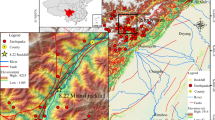Abstract
Tower-shaped rock masses are particularly susceptible to failure, via fracture and disintegration, due to their inherently large height-to-diameter ratio. A rockfall event at the Zengziyan Cliff, in Chongqing, China, was selected for a case study. Based on video footage, the movement characteristics of the initial failure processes were analyzed in three movement stages: initiation, acceleration and deceleration. The failure process began at the bottom of the tower-shaped unstable rock mass and manifested itself in the form of fissure extension followed eventually by disintegration. The acceleration curve presented a continuous negative fluctuation associated with buffering in the deceleration stage. At the same time, the movement characteristic curves at different measurement points displayed significant time-dependent differences, proving that cracking, collisions and disintegration occur in the failed rock mass during the initial failure process. The results of this analysis provide a reference for the early identification of similar rockfalls and for analysis of their mechanisms.









Similar content being viewed by others
References
Bottema D, Roth B, Veldkamp GR (1979) Theoretical kinematics. North-Holland Publishing
Dammeier F, Moore JR, Haslinger F, Loew S (2011) Characterization of alpine rockslides using statistical analysis of seismic signals. J Geophys Res Earth Surf 116(F4):F04024
Dorren LKA (2003) A review of rockfall mechanics and modelling approaches. Prog Phys Geogr 27(1):69–87
Frayssines M, Hantz D (2006) Failure mechanisms and triggering factors in calcareous cliffs of the subalpine ranges (French Alps). Eng Geol 86(4):256–270
Geniş M, Sakız U, Aydıner BÇ (2017) A stability assessment of the rockfall problem around the Gökgöl tunnel (Zonguldak, Turkey). Bull Eng Geol Environ 76(4):1237–1248
Huang B, Yin Y, Liu G, Wang S, Chen X, Huo Z (2012) Analysis of waves generated by Gongjiafang landslide in Wu Gorge, Three Gorges Reservoir, November 23, 2008. Landslides 9(3):395–405
Hungr O (1981) Dynamics of rock avalanches and other types of slope movements. Ph.D. thesis, University of Alberta, Edmonton, Alta
Hungr O, Leroueil S, Picarelli L (2014) The Varnes classification of landslide types, an update. Landslides 11(2):167–194
Hungr O, Evans SG (2004) The occurrence and classification of massive rock slope failure. Felsbau 22(2):16–23
Margottini C, Spizzichino D, Sonnessa A, Puzzilli LM (2015) Natural hazard affecting the Katskhi pillar monastery (Georgia). Eng Geol Soc Terr 8. Springer International Publishing:393–397
Nichol SL, Hungr O, Evans SG (2002) Large-scale brittle and ductile toppling of rock slopes. Can Geotech J 39(4):773–788
Oppikofer T, Jaboyedoff M, Keusen HR (2008) Collapse at the eastern Eiger flank in the Swiss Alps. Nat Geosci 1(8):531–535
Peisser CD, Helmstetter A, Grasso JR, Hantz D (2002) Probabilistic approach to rock fall hazard assessment: potential of historical data analysis. Nat Hazards Earth Syst Sci 2(1/2):15–26
Poisel R, Eppensteiner W (1988) A contribution to the systematics of rock mass movements. 5th Int. Symposium on Landslides, pp 1353–1357
Poisel R, Preh A (2004) Rock slope initial failure mechanisms and their mechanical models. Felsbau 22(2):40–45
Powell JW (1875) Exploration of the Colorado River of the west and its tributaries. Government Printing Office, Washington
Saletan EJ, Cromer AH (1971) Theoretical mechanics. Wiley
Terzaghi K (1950) Mechanism of landslides. Application of geology to engineering practice. Geol Soc Am Vol: 83–123
Vilajosana I, Surinach E, Abellán A, Khazaradze G, Llosa J (2008) Rockfall induced seismic signals: case study in Montserrat, Catalonia. Nat Hazards Earth Syst Sci 8(4):805–812
Yin Y, Zheng W, Li X, Sun P, Li B (2011) Catastrophic landslides associated with the M8.0 Wenchuan earthquake. Bull Eng Geol Environ 70(1):15–32
Zhang ZY, Wang ST, Wang LS (1994) Principles of engineering geology analysis. Chinese Geology, Beijing (In Chinese)
Acknowledgements
This study is conducted with financial support from the National Natural Science Foundation of China (No. 41702342); the Scientific Research Fund of Institute of Geomechanics, CAGS (No. DZLXJK201610); and the China Geological Survey (No. DD20160268-4).
Author information
Authors and Affiliations
Corresponding author
Rights and permissions
About this article
Cite this article
He, K., Chen, C. & Li, B. Case study of a rockfall in Chongqing, China: movement characteristics of the initial failure process of a tower-shaped rock mass. Bull Eng Geol Environ 78, 3295–3303 (2019). https://doi.org/10.1007/s10064-018-1364-9
Received:
Accepted:
Published:
Issue Date:
DOI: https://doi.org/10.1007/s10064-018-1364-9




